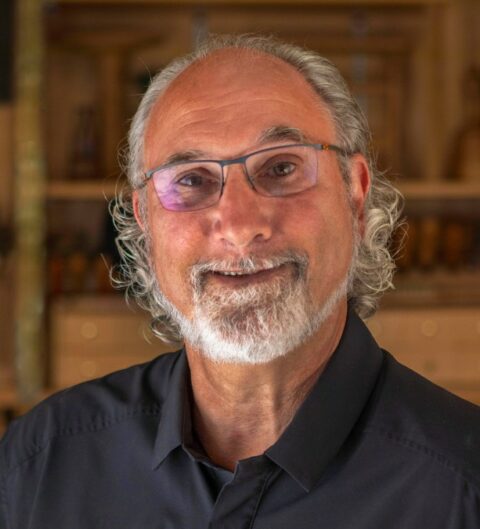“My greatest joy is to help a student discover their own innate abilities and creativity. Students need alternative ways to learn through hands-on experiences found in project-based learning. By implementing multiple learning modalities and providing scaffolded instruction, the resultant skills can serve them well, whatever they choose to do.”
Grateful for the accomplished instructors who have influenced his own nearly four decades of teaching, David Barresi is a woodworking teacher at Frankfort High School in Frankfort, Michigan. While an instructor in Fine and Creative Woodworking at Rockingham Community College, Barresi was honored as “Teacher of the Year” His former program at Bellaire High School received the “Program of Quality Award” from Michigan Industrial Technology Education Society (MITES). Earlier this spring, Barresi was honored by MITES with the Paul Schilling Distinguished Service Award, given to those who make “significant contributions to promote the goals and objectives of industrial and technology education through service to the society”. Barresi’s students have won five state level MITES competitions, and have taken first place four times at the Association of Woodworkers and Furniture Suppliers (AWFS) in Las Vegas, Nevada.
Barresi teaches multiple woodworking skills including furniture making, cabinet making and wood manufacturing. His classroom simulates an ongoing work environment, so students learn not only hands-on wood skills, but also key professionalism and management skills. Students fill out a timecard, which serves as a legitimate record of daily student accomplishments and production progress reports. An individual’s time card has specific categories and encourages the student to examine work productivity closely. Barresi focuses on instilling good communication skills and a strong work ethic and shares from his own personal and professional experiences to coach students. He embeds their projects with practical math and writing opportunities, but also illustrates the profit and financial value of the skills they are learning to emphasize that one does not need to strive for a college degree to achieve a successful and satisfying career.
The culture in his class is based upon cooperative learning and a hierarchy of knowledge. Students of differing experience levels are included in every class. In any classroom, students may be a facilities manager, a shop foreman, an experienced student or a beginning student. As a student progresses through the series of classes, they continuously build upon their previous knowledge, becoming more sophisticated while being given more responsibility. Students create all visual and written documentation relating to their projects.
Barresi utilizes a multifaceted learning process for students of all experience levels to go through all of the processes from preliminary concept of the product to the sale of the product. He provides full-size visual models, adequate class time for process demonstrations and written step-by-step instructions. Students create their own samples and for every product they work on; they create a scale drawing, a parts list, estimate costs, and complete a retail price worksheet, production timeline, and general procedures for them to explore and discover. If students struggle and have questions, they have a variety of options to turn to for assistance and Barresi uses the Socratic method so the class can learn and work together to find solutions. There are different roles and responsibilities for every department, and they collaborate to track their work process and costs and modify the production process in order to remain on time and profitable.
Barresi believes that the most valuable lesson he hopes to teach his students is to be accountable for the quality of one’s work. This accountability includes time management, organizing and monitoring work production, and thoughtful self-evaluation. To nurture autonomy and confidence in setting goals, students self-evaluate their own work with the use of a written rubric. He uses qualitative and quantitative assessments to help individuals utilize the collected data and the self-assessment of their work practices, so that he can individualize each student’s instruction and determine the amount of intervention necessary for the student to be successful and create customized plans moving forward.
At the end of the year, Barresi’s program participates in a school-wide “extravaganza” displaying students’ work, participates in multiple furniture shows/competitions and donates several furniture pieces to their annual fundraiser. This event gains media coverage so that the community can see how the student-centered program develops the skilled trades workforce and entrepreneurs for the future.
Barresi is an accomplished woodworker and furniture designer. He formed the Artisan Design Network, a group of regional craftsmen, and has had his pieces published in Fine Woodworking Design Book Three: 558 Photographs of the Best Work in Wood (1983), 397 Chairs (1988), 500 Chairs: Celebrating Traditional and Innovative Designs (1998), and Mind and Hand Contemporary Studio Furniture (2012). The most recent publication of American Woodworking and Furnishing Show (AWFS) Fresh Wood Design Book (2022) features the work of three of his students, and Barresi notes that he is “humbled that [his] teaching legacy lives on through my students and their extraordinary accomplishments”.
“Major educational reforms must emphasize and enhance career readiness and vocational enrichment within all secondary education programs. Not only do we need to provide opportunities for all students, but from a societal need, we have to address the income disparity and vanishing skilled labor force. At this time, five tradesmen are retiring as one new tradesman comes into the profession.”
